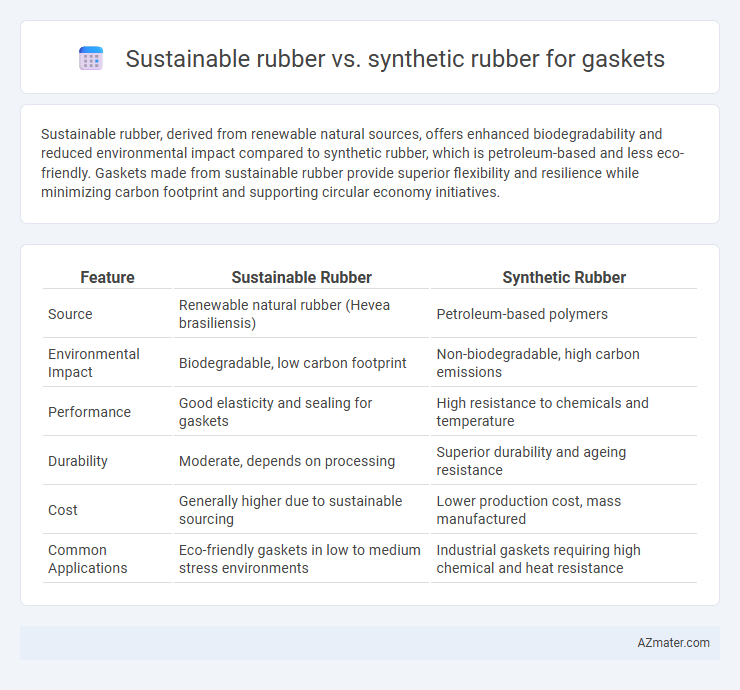Sustainable rubber, derived from renewable natural sources, offers enhanced biodegradability and reduced environmental impact compared to synthetic rubber, which is petroleum-based and less eco-friendly. Gaskets made from sustainable rubber provide superior flexibility and resilience while minimizing carbon footprint and supporting circular economy initiatives.
Table of Comparison
| Feature | Sustainable Rubber | Synthetic Rubber |
|---|---|---|
| Source | Renewable natural rubber (Hevea brasiliensis) | Petroleum-based polymers |
| Environmental Impact | Biodegradable, low carbon footprint | Non-biodegradable, high carbon emissions |
| Performance | Good elasticity and sealing for gaskets | High resistance to chemicals and temperature |
| Durability | Moderate, depends on processing | Superior durability and ageing resistance |
| Cost | Generally higher due to sustainable sourcing | Lower production cost, mass manufactured |
| Common Applications | Eco-friendly gaskets in low to medium stress environments | Industrial gaskets requiring high chemical and heat resistance |
Introduction to Rubber Gaskets
Rubber gaskets serve as crucial sealing components in various industrial applications, ensuring leak-proof connections between surfaces. Sustainable rubber, derived from natural latex harvested from rubber trees, offers renewable and biodegradable properties, reducing environmental impact compared to synthetic rubber produced from petrochemicals. Sustainable rubber gaskets exhibit excellent elasticity, chemical resistance, and durability, making them a viable eco-friendly alternative without compromising performance in sealing solutions.
What is Sustainable Rubber?
Sustainable rubber is produced from natural latex harvested through eco-friendly and socially responsible practices, minimizing environmental impact and supporting biodiversity. It ensures traceability from rubber trees to finished gasket products, promoting renewable resource use and reducing carbon footprint compared to petroleum-based synthetic rubber. This makes sustainable rubber an increasingly preferred material for gaskets in industries prioritizing environmental sustainability and performance durability.
Overview of Synthetic Rubber
Synthetic rubber, primarily derived from petrochemicals such as styrene-butadiene and nitrile butadiene, offers controlled properties including excellent oil resistance, durability, and temperature tolerance, making it ideal for gasket applications in automotive and industrial settings. Unlike sustainable rubber, synthetic variants provide consistent quality and performance but often have a higher environmental footprint due to reliance on non-renewable resources and complex manufacturing processes. Advances in bio-based synthetic rubber aim to reduce ecological impact while maintaining the mechanical strengths required for effective sealing in various gasket uses.
Environmental Impact Comparison
Sustainable rubber, derived from natural latex, offers a significantly lower carbon footprint and higher biodegradability compared to synthetic rubber, which is petroleum-based and contributes to environmental pollution through non-biodegradable waste. The cultivation of sustainable rubber supports carbon sequestration and reduces dependency on fossil fuels, while synthetic rubber production involves energy-intensive processes that emit greenhouse gases and toxic byproducts. Lifecycle assessments highlight that sustainable rubber gaskets contribute less to air and water pollution, making them a more eco-friendly choice for industrial sealing applications.
Material Performance Differences
Sustainable rubber, derived from natural latex, offers superior elasticity and resilience compared to synthetic rubber, enhancing gasket sealing under variable pressure conditions. Synthetic rubber, often made from petroleum-based polymers like nitrile or silicone, provides greater chemical resistance and temperature stability, making it suitable for harsh environments. Performance differences impact gasket durability, with sustainable rubber excelling in flexibility and biodegradability while synthetic rubber delivers higher resistance to oils, solvents, and extreme temperatures.
Cost Efficiency and Availability
Sustainable rubber offers competitive cost efficiency by utilizing renewable resources and reducing reliance on petroleum-based materials, often resulting in stable pricing despite market fluctuations. Its availability is increasing due to growing investment in natural rubber plantations and enhanced harvesting technologies, making it a viable alternative for gaskets in various industries. Synthetic rubber, derived from petrochemicals, remains widely available with consistent quality and supply chains, but its cost is subject to volatility linked to crude oil prices and environmental regulations.
Lifespan and Durability
Sustainable rubber, derived from natural latex, offers superior biodegradability and resistance to environmental degradation compared to synthetic rubber, enhancing gasket lifespan in eco-conscious applications. Synthetic rubber gaskets, composed of polymers like nitrile or silicone, excel in durability under extreme temperatures and chemical exposure, often outlasting natural rubber in industrial settings. Selecting between sustainable and synthetic rubber depends on specific durability requirements and environmental impact priorities for gasket performance.
Industry Applications and Suitability
Sustainable rubber, derived from natural sources like Hevea brasiliensis, offers superior elasticity and biodegradability, making it highly suitable for gasket applications in the food processing, pharmaceutical, and automotive industries where environmental regulations are stringent. Synthetic rubber, such as nitrile or EPDM, provides enhanced resistance to chemicals, heat, and abrasion, fitting industrial settings like oil refining, chemical manufacturing, and heavy machinery where durability and performance under harsh conditions are critical. The choice between sustainable and synthetic rubber gaskets hinges on balancing eco-friendliness with operational requirements specific to industry applications.
Regulatory and Certification Standards
Sustainable rubber for gaskets complies with stringent environmental regulations such as the EU's REACH and ISO 14001 certification, ensuring reduced ecological impact and safer chemical usage. Synthetic rubber products often adhere to industry standards like ASTM D2000 and FDA regulations for food-grade applications, focusing on performance consistency and safety. Regulatory frameworks increasingly favor sustainable materials, driving certification bodies to incorporate lifecycle assessments and carbon footprint metrics into their approval processes.
Choosing the Right Rubber for Gaskets
Sustainable rubber for gaskets offers enhanced environmental benefits, such as biodegradability and reduced carbon footprint, making it ideal for eco-conscious manufacturing. Synthetic rubber provides superior chemical resistance, durability, and temperature tolerance, ensuring optimal gasket performance in demanding industrial applications. Choosing the right rubber depends on balancing sustainability goals with specific operational requirements like exposure to chemicals, temperature ranges, and mechanical stress.

Infographic: Sustainable rubber vs Synthetic rubber for Gasket
 azmater.com
azmater.com